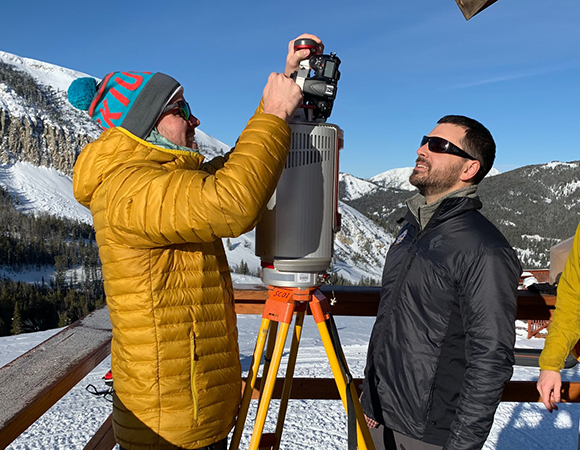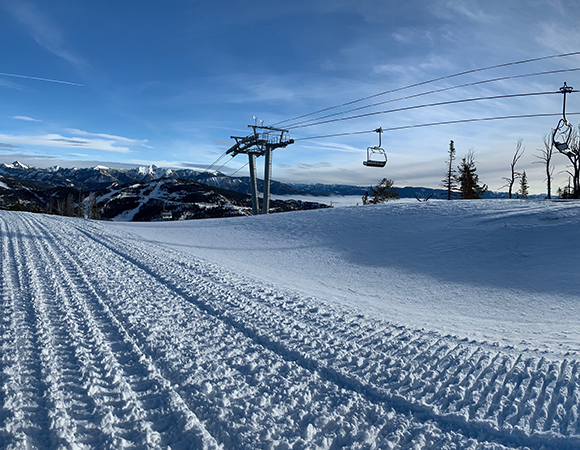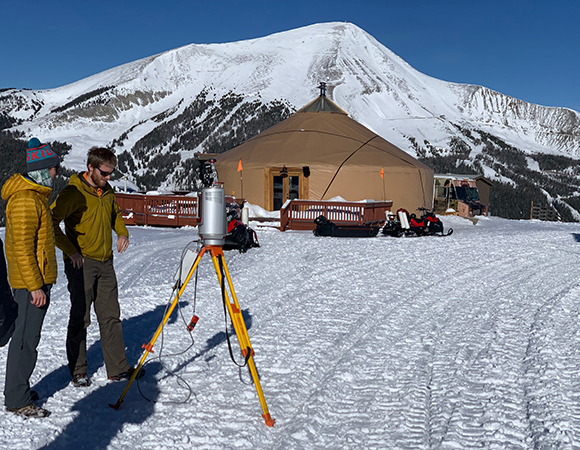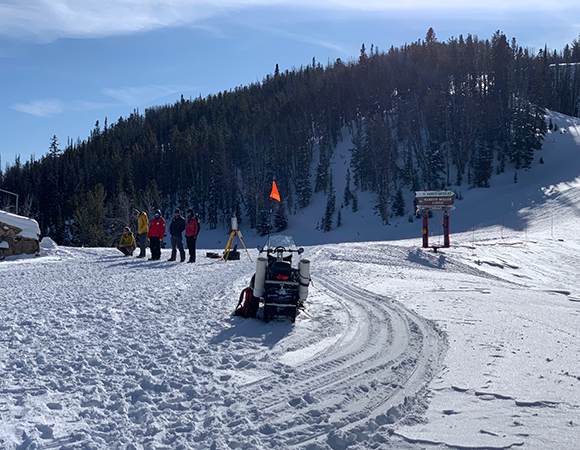
Peter Ottsen (left), Kevin Hammonds (middle), and Sean Yaw (right) set the VZ-6000 up for the first scan. (Photo/Keith Williams, UNAVCO) 
Panorama from the top of the American Spirit Lift at the Yellowstone Club, with Lone Peak to the left. (Photo/Keith Williams, UNAVCO) 
Peter and Sean set up for a second scan at the Yellowstone Club, MT. (Photo/Keith Williams, UNAVCO) 
The MSU crew, done scanning, wait on the second snowmobile with the sled to haul the gear back down the mountain. (Photo/Keith Williams, UNAVCO)
Project Overview
Researchers at Montana State University’s Subzero Research Laboratory (SRL) are exploring the potential for terrestrial laser scanners (TLS) to detect avalanche risk in real-time. An avalanche early warning system could significantly reduce the costs associated with shutting down mountain roadways and ski areas as well as save lives.
In early December 2019, UNAVCO field engineer Keith Williams brought UNAVCO’s Riegl VZ-6000 TLS instrument to SRL and provided two days of training in the lab and in the field to SRL researchers. The researchers have since used the instrument to collect data on various snowpack conditions on-site as well as at multiple outdoor test sites. Typically, UNAVCO has supported TLS work to produce data on characteristics such as slope angles and snow depth, with repeat scans. This research, however, collects information on the intensity of the laser return with the goal to characterize surface properties of the snowpack including grain type, grain size, and density.
Prior research has shown that many of these snowpack properties can be measured from laser returns with a scanner using a wavelength of 1064 nm. The VZ-6000 is the only instrument in the UNAVCO pool that uses this wavelength, but is not eye safe at distances under 295 m. This required a change in the original plans to scan at populated ski resorts. Fortunately, Yellowstone Club invited the team to test in an area of the resort that they could close to all personnel.
Project Outcome
The researchers are testing TLS instruments for accuracy and signal-to-noise ratio as a function of snow depth, density, grain-type, grain-size, surface characteristics, and angle of incidence. These measurements will guide software development for snow remote sensing, data interpretation, and data analytics, as well as being able to provide avalanche forecasters with new insights from real-time TLS data.
Project Information
- Principal Investigator(s): Kevin Hammonds and Sean Yaw, Montana State University Bozeman
- UNAVCO Staff: Keith Williams
- Dates: Dec 4-5, 2019, and ongoing without engineer support through Spring 2020
- Location: MSU Subzero Research Laboratory (SRL) and various field locations
- Funding Source: Department of Transportation
- Map of Montana State University
Related Links
- Montana State University Subzero Research Laboratory
- Four-day Snoqualmie Pass closure cost $27.9 million, Spokane Journal of Business
- Watch an avalanche devour a Colorado highway in seconds, The Washington Post
Written by:
- Keith Williams and Beth Bartel
- Posted: 6 May 2020
- Last updated: 4 June 2021
- Tags: project highlights, TLS


